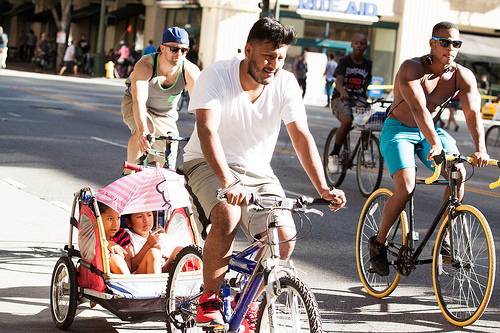Cyclists Have Mixed Views On 3-Foot Passing Law

The law, signed by Gov. Jerry Brown last month, requires drivers to pass cyclists with 3 feet or more of clearance, or to "slow to a speed that is reasonable and prudent."
The law addresses a serious problem for cyclists. In Los Angeles, bike and pedestrian hit-and-runs have become an epidemic.
"Cars always pass too close," said Jeff Chapman of Eagle Rock, who bikes to work and takes his daughter to school by bike. "But once or twice a week it's really close."
Requiring motorists to pass cyclists with caution will also encourage more Californians to bike. A study in Portland, Oregon, shows that 60% of the population is interested in getting around by bike, but does not do so because of safety concerns.
Bikers at CicLAvia, one of the few occasions in L.A. when biking can be truly worry-free, spoke about how they are intimidated to ride on the city's wide streets. "I don't ride as much as I would like to because of safety concerns with traffic," said Brandon Harnsberger, who added that the law makes him "feel a little safer about riding on the streets."
Nonetheless, it may take a long time to change drivers' behavior. A frequent cyclist, Victor Ruiz, said, "Even if the law is implemented, drivers won't care. They're either ignorant and don't know about it, or they just don't care. Drivers don't respect cyclists."
Because of the nature of the law, it is likely to be sporadically enforced. "I appreciate the mindset behind it, protecting cyclists, but I don't see how they would enforce it. Unless a cop is right there at the scene, and can visually estimate whether it's 3 feet, it's going to be very subjective," said Daniel Fabiano of Santa Monica.
He expressed concern that the law would turn out like the California ban on texting while driving, which has done little to curb the problem.
Hayley Babcock, another CicLAvia attendee, thinks that passing with 3 feet of space between an automobile and a cyclist would basically require the driver to change lanes. On many streets, this will probably be the case.
Because of the hazard posed by opening car doors, cyclists should ride 3 feet away from parked cars to avoid the "door zone." Assuming that a bicycle and rider are about a foot wide, a cyclist with a 3-foot buffer on both sides requires 7 feet of space. Given that the average lane is between 10 and 12 feet wide, and that an average car is between 7 and 8 feet wide, a driver will likely have to enter the other lane, if there is one, to pass with the correct distance.
The law has not been entirely well received by drivers. The L.A. Times reports that it has received many letters about the law, some in anger, and some in support.
Similar laws are already in effect in 21 states. While in some places the laws work effectively, in other states, there is little awareness of the required passing distance, and police refuse to enforce the law.
When the law was being debated, the California Highway Patrol came out in opposition, saying that it would cause drivers to crash.
The law will go into effect Sep. 14, 2014.
Read more Neon Tommy stories about bike issues here.
Reach Staff Reporter Axel Hellman here.



